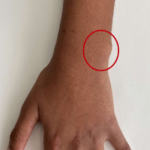The triangular fibrocartilage complex (TFCC) is a complex array of ligaments that stabilize the ulnar aspect of the wrist (the side opposite the thumb). Components include the superficial and deep components of the dorsal radioulnar ligaments, articular disc, ulnolunate ligament, ulnotriquetral ligament, subsheath of the ECU, and meniscal homologue. Injury to the TFCC may occur with trauma or alternatively over time.
 Picture 1: Ulnar aspect of the wrist circled.
Picture 1: Ulnar aspect of the wrist circled.
In acute cases of trauma, partial injuries may occur. Nonoperative treatment such as rest, over-the-counter medication, splinting, therapy and occasionally cortisone injection may assist with symptoms. When partial injuries do not improve, advanced imaging with MRI may be considered. This should be discussed with your treating physician. Surgical treatment with wrist arthroscopy and debridement of the torn central portion of the TFCC may alleviate symptoms. Peripheral tears of the TFCC may be amenable to repair.
Acute cases of trauma involving complete rupture of the deep portion of the TFCC often create instability of the distal radioulnar joint (DRUJ). In these cases, advanced imaging with MRI and potential surgical repair of the TFCC may be discussed with your treating physician.
In chronic TFCC tear, ulnocarpal impaction may contribute to symptoms. The distal ulna may be longer than the distal radius (ulnar positive) and create impingement upon the TFCC and ulnar aspect of the lunate bone. [insert see hyperlink to ulnocarpal impaction article].
In chronic TFCC tear without ulnocarpal impaction or arthritis and with the presence of DRUJ instability, surgical reconstructive techniques may be discussed with your physician. One surgical treatment involves harvesting a tendon from the forearm. Next, tunnels are drilled through the radius and the ulna. The harvested tendon is passed through the drilled tunnels and secured.
The decision regarding nonoperative versus operative treatment is complex and should be discussed with your treating physician.
Outcomes after surgical treatments vary and risks and benefits should be discussed in detail with your treating physician. Nonoperative treatment also carries risks and benefits which should be discussed with your treating physician.
Disclaimer: This information is not intended to covey, substitute or supplant any medical advice. In order to establish a treating relationship, please schedule and complete your visits with a licensed physician.
Copyright 12/10/2021 Tanay Amin, MD Do not copy, distribute, or publish this article. Please contact Precision Hand and Orthopedic Surgery PLLC with regards to any inquiries or corrections.
© 2022 All rights reserved